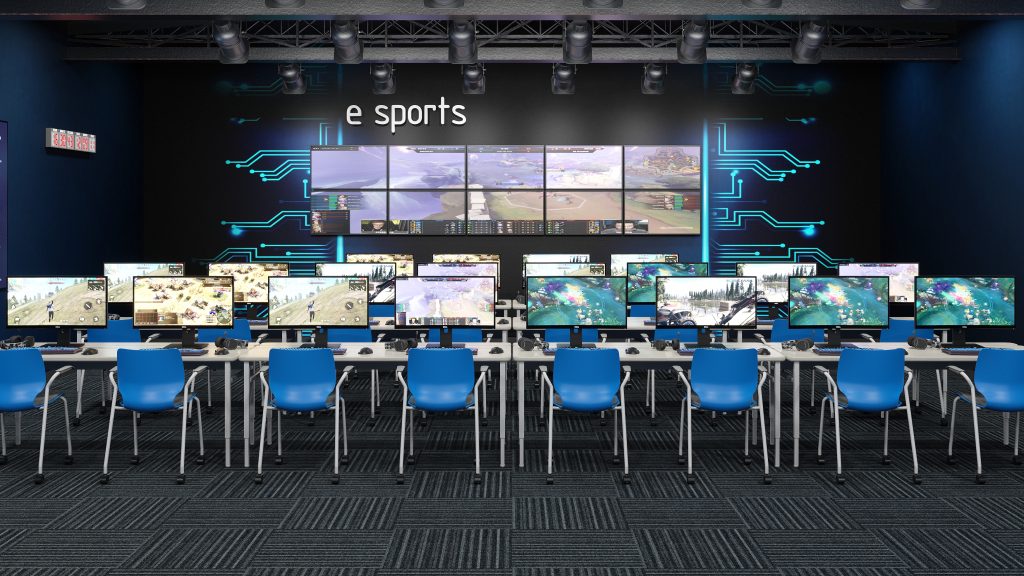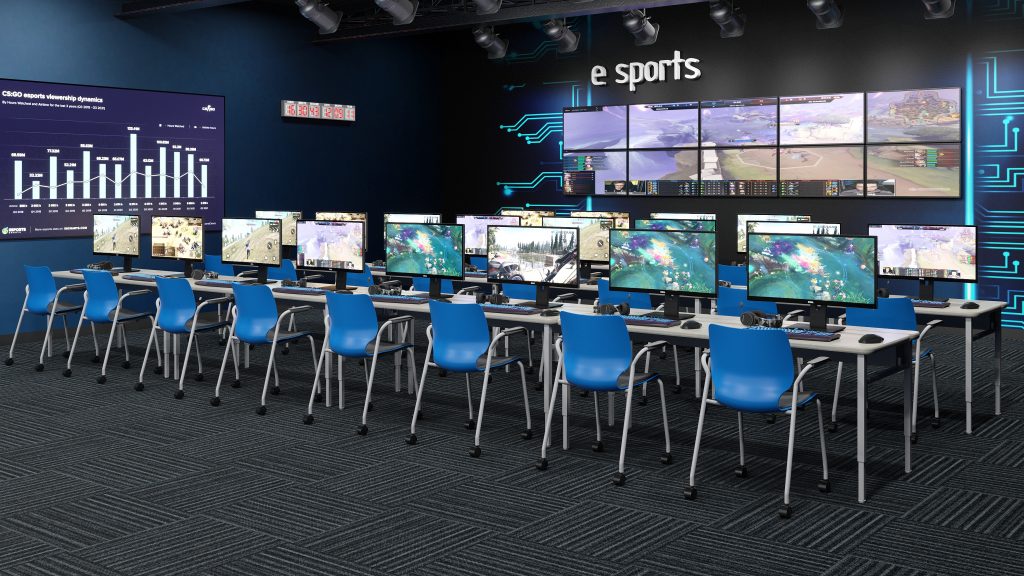
The meteoric rise in high school esports shows it’s much more than child’s play. Esports has blossomed into a hot topic of conversation, spanning from K–12 to higher ed.
How popular is Esports? As of early 2020, 17 states and the District of Columbia offered formal Esports teams. In higher ed, more than 170 colleges and universities participate, with over $16 million in college scholarships.
It’s understandable that some educators and parents may be skeptical, but the educational value of gamification in learning is real, so much so that schools are classifying their high school esports teams, middle school esports teams – and younger – as an academic activity, not athletic. Esports is here to stay.
“Tying Esports to career development, social-emotional learning and academic degrees supports its legitimacy and longevity,” said Joe Simone in his EdTech article titled, “Solidifying a Place for Esports in the Classroom.”
So, why not meet students half way? Create classroom spaces that maximize the benefits of Esports camaraderie and learning.
Esports is short for “electronic sports.” It’s a form of competition where video-gamers square off either in teams or individually. Competitions take place in a multiplayer setting, with prizes or scholarships often awarded at the end of tournaments. Initially, gamers mostly played alone from their homes. Now, tournaments can take place in large arenas, watched live or online by huge audiences. There’s an entire gaming culture with sponsors, merchandise and fans.
In K–12 education, the focus is a bit different. For example, the COVID-19 pandemic prompted the North American Scholastic Esports Federation (NASEF) to focus on community, not competition– part of that was the Minecraft Challenge. Students in grades 3–12 logged into the sandbox game Minecraft and designed their ideal quarantine house. The completed homes could be uploaded online via Flipgrid for all members to see. The competition was free to enter, and winners were eligible for a $500 scholarship, among other prizes.
An international phenomenon for almost a decade, esports has gained more traction in the U.S. Why? Because kids and teens are already passionate about gaming.
sAccording to a 2015 survey from the Pew Research Center, 72% of teens play games on computers, game consoles or cell phones. Though there’s a gap between girls (59%) and boys (84%), the numbers are relatively steady among household income brackets, races and locations. Also, Esports teams and competitions are easily scalable. Most take place remotely and rely on equipment that schools already have or players have at home. That means it’s affordable and teams can continue league play, even if a pandemic forces distance learning.
Esports is about more than just indulging kids’ enthusiasm for video games. Esports channels student fun and their competitive spirit into a structured and adult-supervised opportunity that helps kids connect with school– and in turn, learning. Here are some other benefits:
Academic Development
Proponents say Esports is a springboard to develop critical thinking, problem-solving, STEM knowledge and digital citizenship– skills that are applicable across multiple career paths. Esports can also provide a great environment for English language learners to improve their skills.
Social-Emotional Learning (SEL)
Esports offers many of the same advantages as traditional team sports and extra-curricular clubs– encouraging collaboration, participation and communication skills. Students learn recruitment, cheering for others, and handling victory and defeat.
Student Engagement
The sport is attracting students who usually don’t participate in extracurricular activities. K–12 educators says it boosts student inclusion and engagement throughout school.
Roles for All
There are many ways for students to get involved. Some play competitively, while others maintain the team’s website, run social media accounts, record game videos, or shout-cast (do play-by-play) during livestreams.
Career Opportunities
Students can gain real-world experience that helps them qualify for internships, college scholarships and, eventually, a broad range of careers– from gaming referee or events management to computer programming and game design.
Pathway to Scholarships and College
Esports is providing a viable pathway to college for those who might not have considered it. For example, Ohio State University (OSU) recently launched a first-of-its-kind Esports and game studies undergraduate major that includes “the application of games in health and medicine.”
This topic is still up for debate, but given the popularity of gaming, teachers are finding ways to integrate Esports programs into elementary schools. Choosing appropriate games (with names like Just Dance and Rocket League) for each age group is key.
Anaheim Elementary School District in California has an esports program that emphasizes social and emotional learning. The nine-week curriculum includes lessons on healthy competition and positive citizenship values.
The ingredients for an Esports league are pretty short: physical space, computers and adult supervision. Most schools rearrange existing furniture (another reason why mobile furnishings are important) for game play.
However, don’t overlook the unique needs of these student athletes. They should have active-seating-type chairs that move with their gaming movements. Look for seat pans that provide four-way tilt, good back support and options for casters. Tables and computer screens should adjust to the right eye level. Don’t forget mobile, lockable storage for gaming consoles.

At the college level, Esporting spaces are becoming more sophisticated. In 2019, OSU unveiled a new esports arena for students, both casual gamers and those who want to compete against the best in the nation. The Esports arena includes about 80 gaming computers, consoles and virtual reality systems. There’s a room for competitive gaming with peer universities and a broadcast booth for students to refine their commentary on game play.
If your school isn’t sure how to launch an Esports curriculum, look to an official organization that guides schools, like NASEF. Also consider these parameters.
Team or Club.
Do you want to create an informal social club or an official team that requires students to maintain a certain GPA and behavior expectations? The easiest way for schools to actually begin competing is to join up with one of the established nation-wide leagues like High School Esports League (HSEL), the High School Starleague, or Youth Esports of America. All host tournaments and provide other support for teams.
Age Range.
Consider how your Esports program will differ by age group in terms of games, supervision, practice hours, drills, and expectations.
Size.
HSEL guidelines say a school needs a minimum of five students to be a team, but recommends 10 to ensure your team has enough players for every match. There is no maximum number.
Boundaries.
Set clear boundaries so that students are limiting practicing their Esports skills to the designated practice time.
If teachers, administrators or parents need further convincing, consider this insight from Jason Kirby, HSEL president, on why schools shouldn’t ignore the Esports movement.
“Esports in schools gets kids out of the basement, into the classroom, on a team, and in a collaborative environment with adult supervision, learning and competing.” He said that helps schools make progress toward what really matters.
“Being excited about something, leads [students] to care about school … that means they’re more engaged in class, with better attendance, and that usually leads to better GPAs,” Kirby concluded.
Learn more about how Smith System can help you create your esports space.

Resources

With a reputation for legendary design and top-quality construction, Smith System manufactures furniture exclusively for learning spaces. Smith System is part of the Steelcase family of brands.